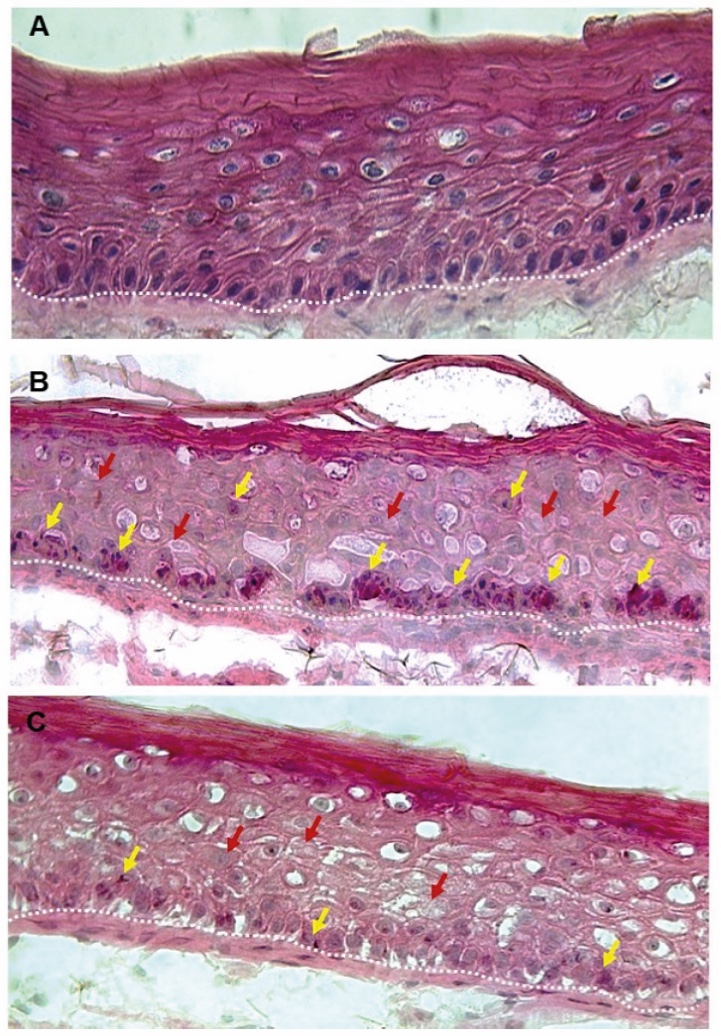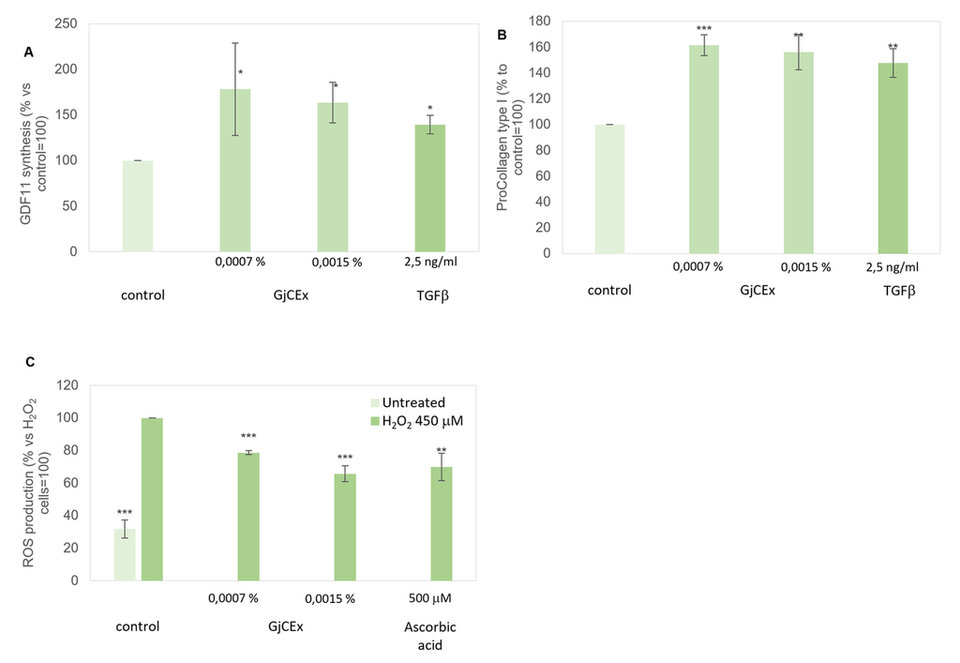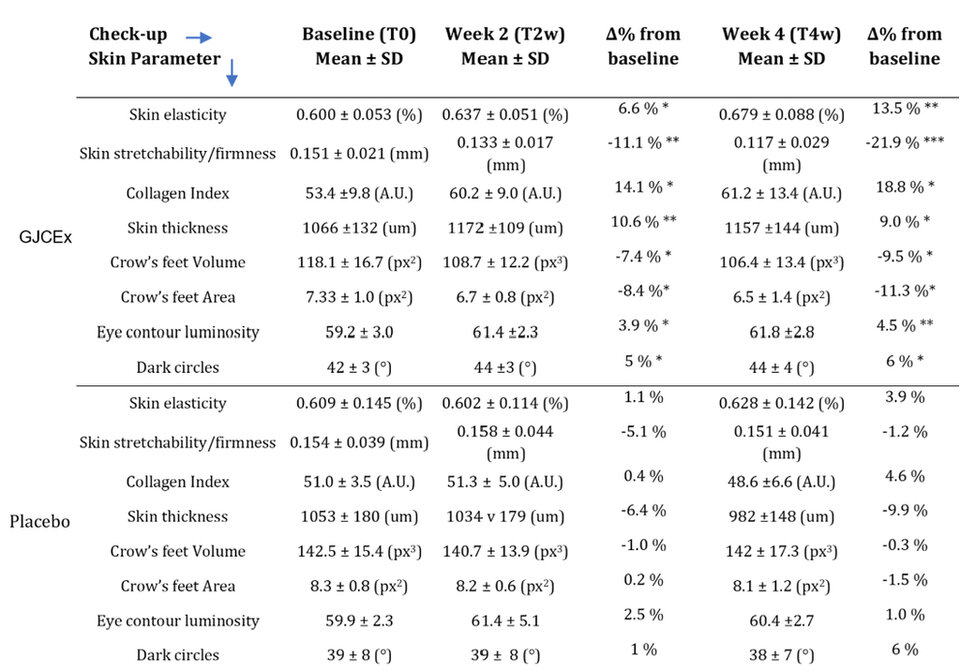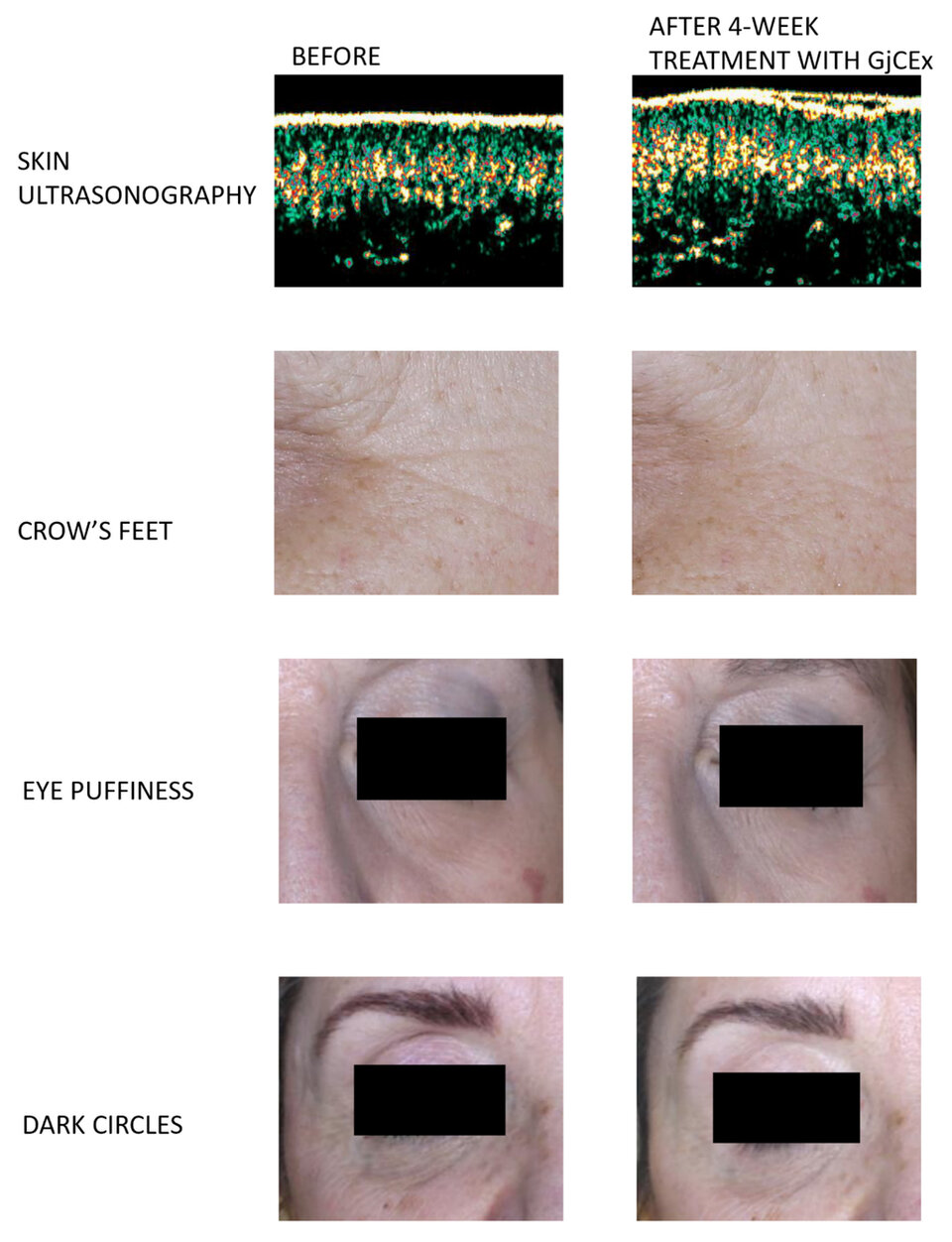Skin care
on
Skin care

peer-reviewed
Skin rejuvenating properties of a powerful blend of Gardenia jasminoides peptides and flavonoids
ANNALISA TITO1*, RITAMARIA DI LORENZO2, NICO CAVALLO1, MARIA GABRIELLA COLUCCI1-3, SONIA LANERI2, TONG ZHANG4, VINCENZO FOGLIANO1-5
*Corresponding author
1. Arterra Bioscience S.p.A., Naples, Italy
2. Dept of Pharmacy, Federico II University of Naples, Italy
3. Vitalab srl (Intercos Group), Naples, Italy
4. Shanghai University of Traditional Chinese Medicine, Shanghai, P. R. China
5. Food Quality & Design group Wageningen University, Wageningen, The Netherlands
ABSTRACT: Gardenia jasminoides, an evergreen Rubiaceae shrub, is one of the most used plants in traditional Chinese medicine (TCM) for the treatment of an array of illness. This is mainly due to its abundant active ingredients, which have impressive anti-oxidant, anti-inflammatory, and immune-modulating properties. However, its potential in cosmetic applications has not been explored until now. In this study we developed a new extract derived from G. Jasminoides in vitro cell culture and we found that the extracts derived from G. jasminoides in vitro cell cultures were able to increase the growth differentiation factor 11 (GDF11) synthesis in skin cells. Following GDF11 activation, Gardenia extracts were able to increase collagen synthesis and reduce ROS production. Clinical studies showed that a blend of peptides and sugars from Gardenia jasminoides cell cultures could rejuvenate skin, reduce the appearance of wrinkles, and depuff and illuminate the eye area.
Introduction
The use of plant phytochemicals with nutritional, medicinal and cosmetic applications, started as far back as 2600 BC (1). In modern times, attaining sustainable development, growing disease-free plants and preserving botanical diversity or endangered plant genotypes, are critical challenges to consider for the sustainable production of phytometabolites.
Plant biotechnology has been largely used in the field of traditional Chinese medicine (TCM), being a powerful tool for the continuous and renewable supply of plant-derived metabolites (2). Biomass cultivation of plant cells, tissue and organ culture can be a useful approach to master the production of bioactive metabolites (3,4) or to preserve the biodiversity of rare or endangered species.
Gardenia jasminoides, an evergreen Rubiaceae shrub, is one of the most used aromatic and medicinal plants in traditional Chinese medicine (TCM). Several studies showed Gardenia metabolites display a wide spectrum of in vitro and in vivo medicinal effects (5,6), however, a study of the phytochemical composition and biological activities of cell suspension of Gardenia jasminoidesis still missing.
Hence, the present work aimed to evaluate the phytochemical composition of Gardenia cell culture extract containing a peptide-enriched fraction obtained by hydrolyzing cell wall glycoproteins using a proprietary strategy (7,8) and its biological activity on skin cells, in particular on GDF11 gene expression. GDF11 is a member of TGFb superfamily of proteins that we previously associated with youth state of skin and hair.
“
“A study in healthy women providing probiotic yogurt for four weeks showed an improvement in emotional responses as measured by brain scans”

Figure 1. Skin Section with Microbiome. Most microorganisms live in the superficial layers of the stratum corneum and in the upper parts of the hair follicles. Some reside in the deeper areas of the hair follicles and are beyond the reach of ordinary disinfection procedures. There bacteria are a reservoir for recolonization after the surface bacteria are removed.
Materials and methods
Studies of major depressive disorder have been correlated with reduced Lactobacillus and Bifidobacteria and symptom severity has been correlated to changes in Firmicutes, Actinobacteria, and Bacteriodes. Gut microbiota that contain more butyrate producers have been correlated with improved quality of life (1).
A study in healthy women providing probiotic yogurt for four weeks showed an improvement in emotional responses as measured by brain scans (2). A subsequent study by Mohammadi et al. (3) investigated the impacts of probiotic yogurt and probiotic capsules over 6 weeks and found a significant improvement in depression-anxiety-stress scores in subjects taking the specific strains of probiotics contained in the yogurt or capsules. Other studies with probiotics have indicated improvements in depression scores, anxiety, postpartum depression and mood rating in an elderly population (4-7).
Other studies have indicated a benefit of probiotic supplementation in alleviating symptoms of stress. In particular, researchers have looked at stress in students as they prepared for exams, while also evaluating other health indicators such as flu and cold symptoms (1). In healthy people, there is an indication that probiotic supplementation may help to maintain memory function under conditions of acute stress.
MATERIALS AND METHODS
Gardenia extracts (GjCEx). An extract rich in peptide and sugars was obtained by Gardenia jasminoides cell cultures according to the protocol described by Apone et al (9). This extract was combined with total hydrosoluble extract derived from the same cells.
Cell line. HaCaT (Human keratinocytes) and HDF (Human Dermal Fibroblast) were maintained in Dulbecco’s modified Eagle’s medium (DMEM)/10% FBS at 37°C under 5% CO2.
In vitro assays
GDF11 and ProCollagen I detection. GDF11 and Pro-Collagen I were measured in HDF by ELISA using specific primary antibody, followed by secondary HRP-labelled antibodies. The proteins were measured by a colorimetric reaction according to the manufacturer’sprotocol (p-Phenylendiamine). The absorbance at 490nm was measured by a multiplate reader Nivo (Perkin Elmer). The absorbance values were normalized to cell density determined by crystal violet staining.
ROS detection. The quantity of reactive oxygen species (ROS) was measured in HaCaT incubated with the extract or ascorbate, used as positive control, for 2 h. At the end, the cells were washed in PBS and incubated with the dye CM-DCFDA (5-(e-6)-clorometil-2,7-dichloro dihydrofluorescein diacetate, Invitrogen). The fluorescence of the samples was thus measured at 535 nm (excitation 490 nm), using the instrument Victor Nivo (PerkinElmer).
Statistical analysis. All presented results are expressed as mean ± standard deviation (SD) of three independent experiments. The statistical significance was calculated trough t-test and the number of asterisks in the graphs indicate the level of significance (*** p-value < 0.001; ** 0.001 < p < 0.01; * 0.01 < p < 0.05). The values are considered significant only if the p-value is ≤ 0.05.
Clinical studies
The cosmetic effects of the Gardenia cell culture extracts were evaluated through a mono-centric, double-blind, placebo-controlled, randomized clinical study.
Healthy women (ages 40 -65; n = 40) were enrolled in this 4-week clinical trial conducted according to the principles of the Helsinki declaration and with the ISO 9001 quality management system with which the RD Cosmetics laboratory of the University of Naples Federico II is certified.
Forty female subjects were selected for eligibility based on the presence of skin laxity and visible signs of premature aging and divided in two group, one supplied with placebo and another one with the same formulation added with 0,5 % w/w Gardenia cell culture extract previously dissolved in glycerol. This concentration mirrors to that used in in vitro assay,
Panelists had to apply on their face the assigned cosmetic treatment twice daily (morning and evening) for 4 weeks. Digital images of all subjects were captured at baseline and at weeks 2 and 4, with VISIA® 7th (Canfield Scientific Inc., Parsippany, NJ 07054 USA) and Visioface® 1000 D (Courage+Khazaka electronic GmbH, Köln, Germany). Computer analysis of the digital images allowed quantification of the eye contour wrinkles (crow’s feet), while the other skin parameters under-observation were detected on test subjects’ face with non-invasive tools of Courage+Khazaka electronics gmbh. More specifically, analysis of elasticity and skin firmness were carried using Cutometer®, eye contour luminosity and dark circles’ reduction were measured with CL 400 Colorimeter® considering the L * and ITA ° parameters, lastly, facial ultrasonography was carried out with Dermascan C 20 MHz probe (Cortex Technology), to provide dermis structural organization before and after treatment with the investigated to confirm the ability of Gardenia cell culture extracts, as a cosmetic ingredient, to firm and densify the skin.
Statistical analysis
For clinical efficacy skin variables (eye contour roughness, skin elasticity, firmness, collagen and thickness, and dark-circles amelioration) were analyzed statistically using SPSS software 15.0 for Windows (SPSS Science, Chicago, IL) through Student t-test for intra-group analysis. A p value <0.05 was considered significant.
RESULTS AND DISCUSSION
Different kind of Gardenia extracts were used in Traditional Chinese Medicine (10) for their therapeutic activity as well as in cosmetics for their positive effects on skin. The most representative bioactive compounds of G. jasminoides include iridoids, organic acids, flavonoids and triterpenes. G. jasminoides cell suspension cultures produce geniposide, recorded as the quality control standard for G. jasminoides in the Chinese Pharmacopoeia while in cell culture extracts there is not genipin, an aglycone of geniposide which is exclusively produced in Gardenia fructus (data not shown).
Up to now no effect of skin rejuvenation mediated by GDF11 induction were reported. GDF11 was identified for the first time as the circulating factor in the blood responsible for rejuvenation effects of heterobiosis experiments in mice (11). We demonstrated that GDF11 has rejuvenating effect in skin cells (12) and very recently in hair follicle ecosystem (13). To evaluate the potential activation on GDF11 by Gardenia extracts derived from in vitro cell cultures we obtained from them a hydrosoluble extract and we combined it with a blend of peptides and sugars obtained by plant cell wall glycoproteins (7,8). Therefore, we measured GDF11 protein synthesis in Human Dermal Fibroblasts treated with Gardenia cell culture extract (GjCEx). As shown in figure 1A, GjCEx used at 0,0007% and 0,0015% significantly upregulated GDF11 level. The effect is comparable to that obtained by TGFb used as positive control revealing a potential effect of skin cell rejuvenation.
Balancing
the skin mocrobiome
Studies of major depressive disorder have been correlated with reduced Lactobacillus and Bifidobacteria and symptom severity has been correlated to changes in Firmicutes, Actinobacteria, and Bacteriodes. Gut microbiota that contain more butyrate producers have been correlated with improved quality of life (1).
A study in healthy women providing probiotic yogurt for four weeks showed an improvement in emotional responses as measured by brain scans (2). A subsequent study by Mohammadi et al. (3) investigated the impacts of probiotic yogurt and probiotic capsules over 6 weeks and found a significant improvement in depression-anxiety-stress scores in subjects taking the specific strains of probiotics contained in the yogurt or capsules. Other studies with probiotics have indicated improvements in depression scores, anxiety, postpartum depression and mood rating in an elderly population (4-7).
Other studies have indicated a benefit of probiotic supplementation in alleviating symptoms of stress. In particular, researchers have looked at stress in students as they prepared for exams, while also evaluating other health indicators such as flu and cold symptoms (1). In healthy people, there is an indication that probiotic supplementation may help to maintain memory function under conditions of acute stress.

Figure 1. Effect of Gardenia jasminoides (Gj) extracts on synthesis of GDF11 (A) and Pro-collagen type I (B) in HDF and on ROS production (C) in HaCaT. GjCEx: Cell extract; FEx: fruit extract; LEx; Leaves extract. Results are reported as percentage mean versus controls.
As direct consequence of GDF11 activation we measured the effects of GjCEx on ProCollagen I synthesis. As shown in figure 1B GjCEx at both used concentrations increased the synthesis of Procollagen I as well as TGFb did. Finally, we tested the antioxidant power of GjCEx in human keratinocytes stressed with H2O2. As shown in figure 1C, they reduced ROS production as positive control, ascorbic acid, did. Considering these results, we decided to further investigate on skin effect of Gardenia cell culture extract (GjCEx) by clinical test on 40 female volunteers. They were divided in two groups, one treated with an emulsion containing GjCEx and another one treated with a placebo. As reported in table 1, different parameters were evaluated after 2 and 4 weeks of treatment of volunteers.

Table 1. Skin wellness parameters changes from baseline to week 4 for the two studied groups – Comparison before/after on test site area. (*p<.0.5, **p<.01, ***p<.001).
Already after 2 weeks, the evaluated parameters related to skin youth state, like skin elasticity, firmness or collagen index were improved. Over the 4-week topical application, skin tone and elasticity were also enhanced, with noticeable outcomes. GjCEx increased Collagen production, leading to a more organized dermis network and denser scaffold, resulting in firmer and more elastic skin. In figure 2, pictures taken before and after 4 weeks of topical treatment with Gj cell extract were reported.

Figure 2. Clinical photos after 4 weeks of treatment with GjCEx containing cream.
As result of improvement of skin youthness parameters evaluated, it is evident in the picture that GjCEx cream effectively reduced the appearance of eye wrinkles and lifted the eye contour area. The eye contour appeared brighter and more relaxed, positively contributing to the overall facial condition.
Conclusions
The results of this study suggest that the G. jasminoides plant cell culture derived extract could be used as active ingredient to prevent and repair skin aging effect. The current investigation provides additional insights about the efficacy of an extract derived from in vitro propagated plant cell culture and overall support the sustainable usage of in vitro propagated cells in the field of TCM resources. A specific blend of sugars and peptides, obtained according to the procedure described in (7-9), from Gardenia jasminoides cell culture had a strong effect in increasing GDF11, a known rejuvenation marker. We demonstrated that activating GDF11 the extract can stimulate new extracellular matrix proteins as revealed by in vitro and in vivo test. Furthermore, this extract was able to give a remarkable youth appearance in female volunteers.
References and notes
- Dias DA, Urban S, Roessner U. A historical overview of natural products in drug discovery. Metabolites. 2012 Apr 16;2(2):303-36. Available from: https://doi.org/10.1016/j.drudis.2008.07.004.
- Atanasov AG, et al. Discovery and resupply of pharmacologically active plant-derived natural products: A review. Biotechnol Adv. 2015 Dec;33(8):1582-1614. Available from: https://doi.org/10.1016/j.biotechadv.2015.08.001.
- Ceccacci S, et al. Jasminum sambac Cell Extract as Antioxidant Booster against Skin Aging. Antioxidants (Basel). 2022 Dec 6;11(12):2409. Available from: https://doi.org/10.3390/antiox11122409.
- Dini I, et al. An Extract from Ficus carica Cell Cultures Works as an Anti-Stress Ingredient for the Skin. Antioxidants (Basel). 2021 Mar 25;10(4):515. Available from: https://doi.org/10.3390/antiox10040515.
- Xiao W, Li S, Wang S, Ho CT. Chemistry and bioactivity of Gardenia jasminoides. J Food Drug Anal. 2017 Jan;25(1):43-61. Available from: https://doi.org/10.1016/j.jfda.2016.11.005.
- Saravanakumar K, et al. Metabolite Profiling of Methanolic Extract of Gardenia jasminoides by LC-MS/MS and GC-MS and Its Anti-Diabetic, and Anti-Oxidant Activities. Pharmaceuticals (Basel). 2021 Jan 28;14(2):102. Available from: https://doi.org/10.3390/ph14020102.
- WO2007104489. Method for the preparation of a composition based on 4-hydroxyproline and the uses thereof in the agronomical field.
- MI2008A 000449. Composizione cosmetica a base di una miscela di peptidi e zuccheri di origine vegetale.
- Apone F, et al. A mixture of peptides and sugars derived from plant cell walls increases plant defense responses to stress and attenuates ageing-associated molecular changes in cultured skin cells. J Biotechnol. 2010 Feb 15;145(4):367-76.Available from: https://doi.org/10.1016/j.jbiotec.2009.11.021.
- Chen L, Li M, Yang Z, Tao W, Wang P, Tian X, Li X, Wang W. Gardenia jasminoides Ellis: Ethnopharmacology, phytochemistry, and pharmacological and industrial applications of an important traditional Chinese medicine. J Ethnopharmacol. 2020 Jul 15;257:112829. Available from: https://doi.org/10.1016/j.jep.2020.112829.
- Sinha M. et al. Restoring systemic GDF11 levels reverses age-related dysfunction in mouse skeletal muscle. Science. 2014 May 9;344(6184):649-52. Available from: https://www.science.org/doi/10.1126/science.1251152.
- Tito A, et al. The Growth Differentiation Factor 11 is Involved in Skin Fibroblast Ageing and is Induced by a Preparation of Peptides and Sugars Derived from Plant Cell Cultures. Mol Biotechnol. 2019 Mar;61(3):209-220. Available from: https://doi.org/10.1007/s12033-019-00154-w.
- Tito A, Tortora A, Falanga D, Colucci MG, Fogliano V. Identification of a novel rejuvenation marker for the hair follicle ecosystem. 33th IFSCC Congress, Barcelona, 4-7 september 2023.
